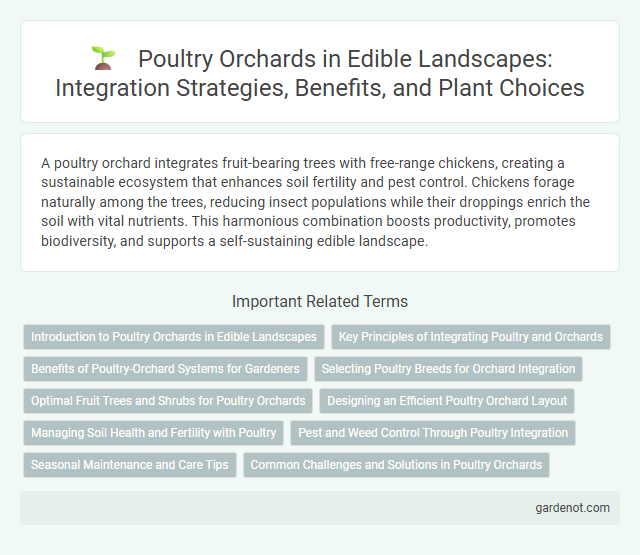A poultry orchard integrates fruit-bearing trees with free-range chickens, creating a sustainable ecosystem that enhances soil fertility and pest control. Chickens forage naturally among the trees, reducing insect populations while their droppings enrich the soil with vital nutrients. This harmonious combination boosts productivity, promotes biodiversity, and supports a self-sustaining edible landscape.
Introduction to Poultry Orchards in Edible Landscapes
Poultry orchards integrate free-ranging chickens or other poultry within fruit tree plantings, creating a symbiotic ecosystem that enhances soil fertility and pest control. The natural behavior of poultry aerates the soil and reduces insect populations, promoting healthier tree growth without chemical interventions. This sustainable approach aligns with permaculture principles, increasing productivity and biodiversity in edible landscapes.
Key Principles of Integrating Poultry and Orchards
Poultry orchards combine fruit trees with free-ranging chickens to enhance soil fertility and pest control through natural foraging behaviors. Strategic placement of poultry shelters and rotational grazing preserves tree root systems while maximizing nutrient cycling and reducing the need for chemical inputs. Maintaining a balanced density of birds prevents soil compaction and promotes orchard biodiversity, supporting a sustainable agroecological system.
Benefits of Poultry-Orchard Systems for Gardeners
Poultry-orchard systems enhance soil fertility by naturally cycling nutrients through manure, reducing the need for synthetic fertilizers. Chickens and other poultry control pests effectively, decreasing damage to fruit trees and promoting healthier orchard yields. Integrating poultry also supports sustainable pest management and increases biodiversity, making it a cost-efficient strategy for gardeners.
Selecting Poultry Breeds for Orchard Integration
Choosing poultry breeds for orchard integration requires considering foraging behavior, climate adaptability, and pest control effectiveness to maintain tree health and soil fertility. Heritage breeds such as Rhode Island Reds and Sussex excel in scratching and insect consumption, promoting natural pest management while contributing organic fertilizer. Selecting dual-purpose breeds with robust disease resistance ensures sustainable synergy between poultry and fruit production within the edible landscape.
Optimal Fruit Trees and Shrubs for Poultry Orchards
Optimal fruit trees and shrubs for poultry orchards include mulberry, cherry plum, and fig, which provide abundant shade and nutrient-rich fruit that support poultry health. Plants like blackberries and currants offer dense cover and high antioxidant content, promoting natural foraging behavior. Selecting species with durable wood and low toxicity ensures a sustainable environment for poultry grazing and nesting.
Designing an Efficient Poultry Orchard Layout
Designing an efficient poultry orchard layout involves optimizing space to balance tree coverage with open areas for poultry movement and foraging. Incorporate a variety of fruit and nut-bearing trees that provide shade, shelter, and nutrition while allowing sunlight to reach the ground to support pasture growth. Implement rotational grazing zones and natural barriers to promote soil health, control parasites, and enhance sustainable poultry management within the edible landscape.
Managing Soil Health and Fertility with Poultry
Poultry orchards enhance soil health and fertility by integrating chicken foraging which naturally aerates the soil and promotes nutrient cycling. Manure from poultry acts as a rich organic fertilizer, increasing soil nitrogen, phosphorus, and potassium levels essential for plant growth. Implementing rotational grazing in poultry orchards prevents soil compaction and maintains balanced nutrient distribution for sustainable edible landscapes.
Pest and Weed Control Through Poultry Integration
Poultry integration in edible landscapes enhances pest and weed control by naturally reducing insect populations and disturbing weed growth. Chickens, ducks, and other poultry forage through orchards, consuming pests such as beetles, caterpillars, and larvae, minimizing the need for chemical pesticides. Their scratching behavior aerates the soil and disrupts weed germination, promoting healthier plant growth and sustainable orchard management.
Seasonal Maintenance and Care Tips
Poultry orchards require seasonal maintenance such as cleaning and rotating pasture areas to prevent disease and promote healthy soil. Regular inspection of water sources and feeders ensures poultry hydration and nutrition during temperature fluctuations. Pruning fruit trees and managing vegetation also supports year-round foraging opportunities and optimal orchard productivity.
Common Challenges and Solutions in Poultry Orchards
Poultry orchards often face challenges such as predator attacks, nutrient management, and disease control, which can impact bird health and orchard productivity. Implementing secure fencing, rotational grazing, and integrated pest management helps mitigate predation and disease risks while maintaining soil fertility through natural manure distribution. Selecting disease-resistant poultry breeds and ensuring proper shelter with adequate ventilation further enhances resilience and overall sustainability in poultry orchards.
Poultry orchard Infographic

 gardenot.com
gardenot.com